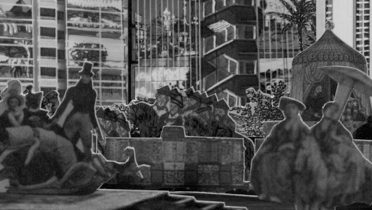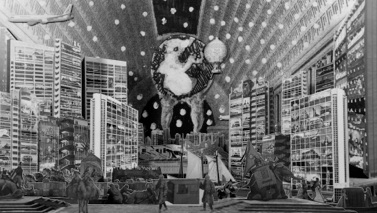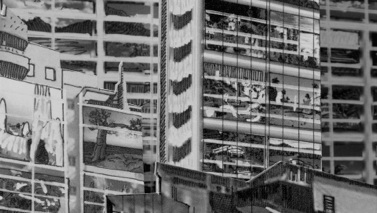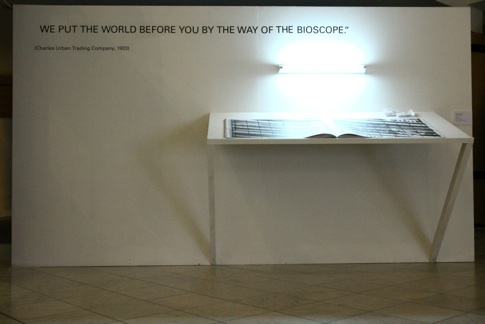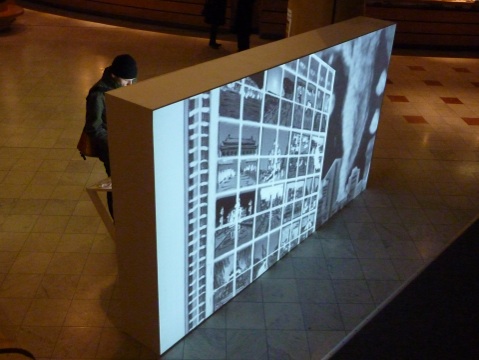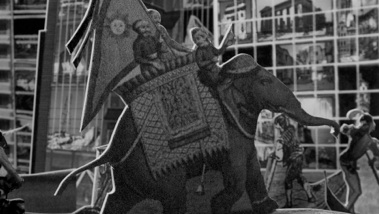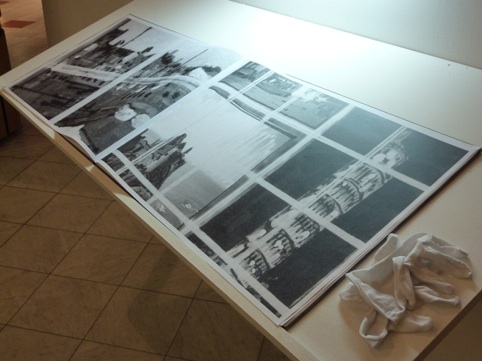artists / researchers




Mira Sanders
THE JOURNEY
2009 | Installation with video projection on specific partition (350 x 40 x 200 cm) and book video | B&W | mute | 5' | looped
Co-production Contour Mechelen VZW,with the support of the Flemish authorities
The Journey is a journey through the history and iconography of tourism. The piece is made up of several elements, presented on the two sides of one and the same broad partition, about 10 feet in length, installed in the lobby of the Maison de la Culture. A black and white video is projected on one of the two sides. The image, which covers this entire surface, seems to be laid on the floor, held in place by the volume of the partition, and detaches itself from the surrounding space like an “image block” producing its own light. The images themselves duplicate this impression of depth, because, if, in an initial stage, they conjure up an animated film, what is in fact involved is the very slow filming of an actual maquette—as if programmed by a system of “motion control”. This maquette brings together factors to do with the history of tourism in one and the same bustling landscape: the large buildings identified as those of tourist complexes built in the 1960s rub shoulders with various means of locomotion, from the oldest to the most recent—from the bicycle to the airplane, by way of the yacht and the airship. In the foreground, several characters illustrate the figure of the traveller. In the window frames of the buildings appear not interiors, but panoramic views over more or less well-known monuments and tourist sites, such as the little mermaid in Copenhagen and the Atomium in Brussels. Mira Sanders has organized this large model with features chosen from a selection of documents either found or constructed during her travels, then redrawn or altered by drawing: old prints, postcards, cut-out shapes, and highlights of paint underscoring images, all are part and parcel of this large relief collage. The camera, like a gaze in motion, scans the details of this landscape with a slow tracking shot which runs over the maquette from top to bottom and from left to right. A reverse tracking movement winds up this motion by revealing the maquette in its entirety. The onlooker then sees that this whole imaginary city is housed beneath the roof of the royal library, a project that was the brainchild of the visionary 18th century architect Etiennne-Louis Boullée. The modern project of having knowledge of the world from industrial innovations thus seems to be on view, in the manner of 19th century World Fairs.
The other side of the partition bears a quotation by Charles Urban, a historic producer of short travel films active in the early 20th century: “We put the world before you by way of the bioscope”. Below this sentence, a display case enables viewers to leaf through a large book of pictures, in the Italian-style format, representing details of the glazed surfaces of buildings reflecting views of landscapes in tourist hotspots all over the world.
The Journey thus proposes a universal archive of tourism; but by electing to re-draw the contents rather than simply reproduce the images as she found them, Mira Sanders creates a discrepancy in the representation of these elements, thus inviting an oblique, critical look. She has chosen to link her investigation into tourism to the issue of representation, and if the video of The Journey illustrates past and present means of transport which have altered our perception of the world, it is a camera which gets us to travel in this landscape. So, while the images in the book introduce a reference to landscape painting, the Charles Urban quote about the bioscope (one of the first pieces of optical apparatus to set photographs in motion) attracts the spectator’s attention to the power of illusion introduced by the relief and the movement into the images. In the video, the windows of the buildings refer, it just so happens, to this power, by borrowing the framing of postcards, which divides the major tourist destinations thus frozen in “snapshots”, recognized by one and all, into nothing less than stereotypes.
On this subject, Mira Sanders explains that the point of departure of this work was the experience of her stay in Cyprus in 2008, which revealed to her the paradoxical situation of Western tourism in a place of tension and sadness. The deserted tourist complex in Famagusta also struck her, because all those buildings identified as being standards of the triumphant tourism of the 1960s are now empty. Built for leisure, these buildings are nowadays suspended in time, and have become monuments of the island’s painful history.
This questioning of images and the representation of space informs the whole of Mira Sanders’s oeuvre, which she herself defines with the title: “Diary of a User of Space”. She was inspired to use this expression by Georges Perec’s book Espèces d’espaces [Species of Spaces]. For her, it is a matter of “facing our culture, questioning our cultural conditioning, and our way of perceiving, and realizing that perhaps we are victims of our own cultural conditioning”.
Charlène Dinhut - Françoise Parfait - Eric Valette
Translated by Simon Pleasance & Fronza Woods
